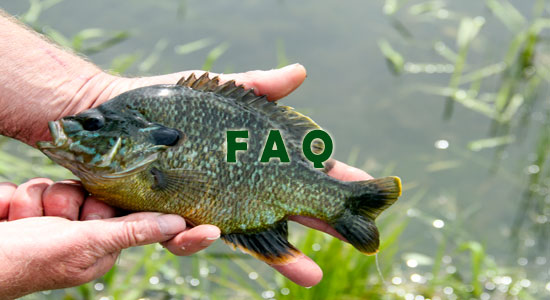
Raising Bluegill Fish Frequently Asked Questions Here are 15 frequently asked questions about raising bluegill fish:Bluegill farming requires an understanding of their dietary needs, water quality management, and stocking density. Bluegill adapt well to ponds or tanks, but careful monitoring of oxygen levels and filtration is essential to maintain a healthy environment. How To Raise Bluegill Yes, bluegill are a popular choice for aquaponics because they adapt well to closed systems, have a broad diet, and tolerate varying temperatures. They provide nutrients to plants through their waste, creating a sustainable and efficient growth cycle. 12 Things To Know Before You Start Raising Bluegill Bluegill are omnivorous, feeding on insects, small fish, and plants. In a farmed setting, they should be fed a balanced diet of commercial pellets and natural foods (e.g., worms, insects) two to three times daily, depending on the season and water temperature. Bluegill growth rates vary but can reach 6-8 inches in their first two years under optimal conditions. Growth depends on water temperature, food availability, and stocking density, with warmer water and high-quality feed promoting faster growth. Bluegill thrive in water temperatures between 65°F and 80°F (18°C 27°C). Temperatures within this range promote healthy growth and activity, while extreme temperatures can stress the fish and slow their growth. Bluegill typically breed in warmer temperatures, around 70°F to 75°F (21°C 24°C). Providing substrate for nesting (e.g., sand or gravel) and maintaining stable, clean water conditions can encourage spawning in spring and early summer. Tilapia grow faster and reach market size quicker, but bluegill are more adaptable to cooler climates and tolerate a broader range of water conditions. Bluegill also have a more desirable taste for some markets and are often less invasive. Crappie are more sensitive to water quality and less adaptable to high-density farming than bluegill. Bluegill are typically preferred for aquaculture because they are hardier, grow well in various conditions, and are more tolerant of tank environments. Yes, bluegill are viable for commercial aquaculture due to their hardiness, adaptability to different water conditions, and suitability for both pond and tank farming. They are also marketable for their mild flavor and are increasingly popular in aquaponics. In aquaponics, bluegill waste provides essential nutrients for hydroponically grown plants. The hydroponic component relies on fish waste, which is converted by bacteria into nitrates for plant growth, creating a mutually beneficial system. A 50-100 gallon tank is recommended for raising bluegill, with larger tanks needed for multiple fish. Tank size should allow sufficient space for bluegill to grow, as overcrowding can lead to stress and poor water quality. As omnivores, bluegill can consume a variety of foods, including insects, plants, and commercial feed, making them easy to manage in diverse environments. Their adaptable diet allows them to thrive in both natural and aquaculture settings. Common issues include parasites, bacterial infections, and fungal diseases. Regular health checks, maintaining good water quality, and proper nutrition help in preventing and managing diseases. Bluegill spawn in warm water during late spring and summer. Males build nests in shallow water and attract females to lay eggs. Eggs hatch within a few days, and fry are cared for by the males until they are free-swimming. Ensure proper pond management with adequate aeration, vegetation for cover, and control of predators. Regularly monitor water quality and provide supplemental feeding if natural food sources are insufficient. Yes, bluegill can be raised in tanks or recirculating aquaculture systems. These systems require careful management of water quality, temperature, and feeding to ensure healthy growth. Bluegill are easy to raise, grow quickly, and are popular for sport fishing. They can also be a valuable source of food in aquaponics systems or for personal consumption. Handle bluegill gently to minimize stress and injury. Use nets or traps to catch the fish and transfer them to a processing area with care. Challenges include managing water quality, preventing diseases, controlling predators, and ensuring adequate feeding. Proper system design and maintenance are crucial for success. Regulations vary by region and may include rules on water use, fish stocking, and environmental impact. Check local regulations and obtain necessary permits for raising bluegill. Yes, bluegill can be raised for commercial purposes, including for food, bait, or recreational fishing. Commercial operations require careful management of production systems and adherence to regulatory requirements. "Want To Raise Healthy Bluegill? Get Gerard Dawn's Ebook That Will Guide You On How To Raise Healthy Profitable Bluegill For Meat In Your Own Farm Yard Even If You're
|
How To Raise Rainbow Trout Contact Us Terms of Use Privacy Policy About Us FAQ Site Map
